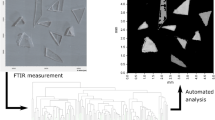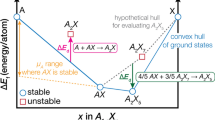Abstract
Pt nanoclusters play an important role in catalysis-related applications. Essential to their activities are their geometries and energy landscapes. In this work, we studied the energy landscapes of Pt clusters using a parallel differential evolution optimization algorithm and an accelerated ab initio atomic relaxation method, which allowed us to explore unprecedentedly large numbers of geometry local minima at ab initio level. We found many lower-energy isomers with low symmetry in their geometry. The energy landscapes were demonstrated to be glass-like with a large number of local minimum structures close to the global minimum. The electronic and magnetic properties of most glass-like local minima were dramatically different from the global minimum, and they should be observed in the experimental measurements. The connections between these local minima were further analyzed using data mining techniques.

Similar content being viewed by others
References
Vayssilov, G. N.; Lykhach, Y.; Migani, A.; Staudt, T.; Petrova, G. P.; Tsud, N.; Skála, T.; Bruix, A.; Illas, F.; Prince, K. C. et al. Support nanostructure boosts oxygen transfer to catalytically active platinum nanoparticles. Nat. Mater. 2011, 10, 310–315.
Allian, A. D.; Takanabe, K.; Fujdala, K. L.; Hao, X. H.; Truex, T. J.; Cai, J.; Buda, C.; Neurock, M.; Iglesia, E. Chemisorption of CO and mechanism of CO oxidation on supported platinum nanoclusters. J. Am. Chem. Soc. 2011, 133, 4498–4517.
Chin, Y. H.; Buda, C.; Neurock, M.; Iglesia, E. Reactivity of chemisorbed oxygen atoms and their catalytic consequences during CH4-O2 catalysis on supported Pt clusters. J. Am. Chem. Soc. 2011, 133, 15958–15978.
Vajda, S.; Pellin, M. J.; Greeley, J. P.; Marshall, C. L.; Curtiss, L. A.; Ballentine, G. A.; Elam, J. W.; Catillon-Mucherie, S.; Redfern, P. C.; Mehmood, F. et al. Subnanometre platinum clusters as highly active and selective catalysts for the oxidative dehydrogenation of propane. Nat. Mater. 2009, 8, 213–216.
Viñes, F.; Gomes, J. R. B.; Illas, F. Understanding the reactivity of metallic nanoparticles: Beyond the extended surface model for catalysis. Chem. Soc. Rev. 2014, 43, 4922–4939.
Baletto, F.; Ferrando, R. Structural properties of nanoclusters: Energetic, thermodynamic, and kinetic effects. Rev. Mod. Phys. 2005, 77, 371–423.
Ferrando, R.; Jellinek, J.; Johnston, R. L. Nanoalloys: From theory to applications of alloy clusters and nanoparticles. Chem. Rev. 2008, 108, 845–910.
Johnston, R. L. Atomic and Molecular Clusters; Taylor and Francis: London, UK, 2002.
Marks, L. D. Experimental studies of small particle structures. Rep. Prog. Phys. 1994, 57, 603–649.
Wales, D. J.; Scheraga, H. A. Global optimization of clusters, crystals, and biomolecules. Science 1999, 285, 1368–1372.
De, S.; Schaefer, B.; Sadeghi, A.; Sicher, M.; Kanhere, D. G.; Goedecker, S. Relation between the dynamics of glassy clusters and characteristic features of their energy landscape. Phys. Rev. Lett. 2014, 112, 083401.
Schaefer, B.; Pal, R.; Khetrapal, N. S.; Amsler, M.; Sadeghi, A.; Blum, V.; Zeng, X. C.; Goedecker, S.; Wang, L. S. Isomerism and structural fluxionality in the Au26 and Au26 - nanoclusters. ACS Nano 2014, 8, 7413–7422.
Gerber, T.; Knudsen, J.; Feibelman, P. J.; Gránä s, E.; Stratmann, P.; Schulte, K.; Andersen, J. N.; Michely, T. Co-induced smoluchowski ripening of Pt cluster arrays on the graphene/Ir(111) moiré. ACS Nano 2013, 7, 2020–2031.
Kumar, V.; Kawazoe, Y. Evolution of atomic and electronic structure of Pt clusters: Planar, layered, pyramidal, cage, cubic, and octahedral growth. Phys. Rev. B 2008, 77, 205418.
Xiao, L.; Wang, L. C. Structures of platinum clusters: Planar or spherical? J. Phys. Chem. A 2004, 108, 8605–8614.
Wang, X. L.; Tian, D. X. Structures and structural evolution of Ptn (n = 15–24) clusters with combined density functional and genetic algorithm methods. Comput. Mater. Sci. 2009, 46, 239–244.
Chen, Z. H.; Jiang, X. W.; Li, J. B.; Li, S. S.; Wang, L. W. PDECO: Parallel differential evolution for clusters optimization. J. Comp. Chem. 2013, 34, 1046–1059.
Doye, J. P. K.; Wales, D. J. Global minima for transition metal clusters described by Sutton–Chen potentials. New J. Chem. 1998, 22, 733–744.
Pavan, L.; Di Paola, C.; Baletto, F. Sampling the energy landscape of Pt13 with metadynamics. Eur. Phys. J. D 2013, 67, 24.
Chaves, A. S.; Rondina, G. G.; Piotrowski, M. J.; Tereshchuk, P.; Da Silva, J. L. F. The role of charge states in the atomic structure of Cun and Ptn (n = 2–14 atoms) clusters: A DFT investigation. J. Phys. Chem. A 2014, 118, 10813–10821.
Goedecker, S.; Hellmann, W.; Lenosky, T. Global minimum determination of the Born–Oppenheimer surface within density functional theory. Phys. Rev. Lett. 2005, 95, 055501.
Bhattacharyya, K.; Majumder, C. Growth pattern and bonding trends in Ptn (n = 2–13) clusters: Theoretical investigation based on first principle calculations. Chem. Phys. Lett. 2007, 446, 374–379.
Lai, X. J.; Xu, R. C.; Huang, W. Q. Geometry optimization of bimetallic clusters using an efficient heuristic method. J. Chem. Phys. 2011, 135, 164109.
Zhai, H. C.; Ha, M. A.; Alexandrova, A. N. AFFCK: Adaptive force-field-assisted ab initio coalescence kick method for global minimum search. J. Chem. Theory Comput. 2015, 11, 2385–2393.
Wei, G. F.; Liu, Z. P. Subnano Pt particles from a firstprinciples stochastic surface walking global search. J. Chem. Theory Comput. 2016, 12, 4698–4706.
De, S.; Willand, A.; Amsler, M.; Pochet, P.; Genovese, L.; Goedecker, S. Energy landscape of fullerene materials: A comparison of boron to boron nitride and carbon. Phys. Rev. Lett. 2011, 106, 225502.
Vilhelmsen, L. B.; Hammer, B. Systematic study of Au6 to Au12 gold clusters on MgO(100) F centers using densityfunctional theory. Phys. Rev. Lett. 2012, 108, 126101.
Doye, J. P. K.; Meyer, L. Mapping the magic numbers in binary Lennard-Jones clusters. Phys. Rev. Lett. 2005, 95, 063401.
Wales, D. J. A microscopic basis for the global appearance of energy landscapes. Science 2001, 293, 2067–2070.
Ballard, A. J.; Martiniani, S.; Stevenson, J. D.; Somani, S.; Wales, D. J. Exploiting the potential energy landscape to sample free energy. Wiley Interdiscip. Rev.: Comput. Mol. Sci. 2015, 5, 273–289.
Wales, D. J.; Salamon, P. Observation time scale, free-energy landscapes, and molecular symmetry. Proc. Natl. Acad. Sci. USA 2014, 111, 617–622.
Aprà, E.; Ferrando, R.; Fortunelli, A. Density-functional global optimization of gold nanoclusters. Phys. Rev. B 2006, 73, 205414.
Doll, K.; Schön, J. C.; Jansen, M. Ab initio energy landscape of LiF clusters. J. Chem. Phys. 2010, 133, 024107.
Santambrogio, G.; Brü mmer, M.; Wö ste, L.; Dö bler, J.; Sierka, M.; Sauer, J.; Meijer, G.; Asmis, K. R. Gas phase vibrational spectroscopy of mass-selected vanadium oxide anions. Phys. Chem. Chem. Phys. 2008, 10, 3992–4005.
Al-Sunaidi, A. A.; Sokol, A. A.; Catlow, C. R. A.; Woodley, S. M. Structures of zinc oxide nanoclusters: As found by revolutionary algorithm techniques. J. Phys. Chem. C 2008, 112, 18860–18875.
Hartke, B. Global geometry optimization of clusters guided by N-dependent model potentials. Chem. Phys. Lett. 1996, 258, 144–148.
Wang, Y. C.; Lv, J.; Zhu, L.; Ma, Y. M. Crystal structure prediction via particle-swarm optimization. Phys. Rev. B 2010, 82, 094116.
Roberts, C.; Johnston, R. L. Investigation of the structures of MgO clusters using a genetic algorithm. Phys. Chem. Chem. Phys. 2001, 3, 5024–5034.
Flikkema, E.; Bromley, S. T. A new interatomic potential for nanoscale silica. Chem. Phys. Lett. 2003, 378, 622–629.
Johnston, R. L. Evolving better nanoparticles: Genetic algorithms for optimising cluster geometries. Dalton Trans. 2003, 4193–4207.
Catlow, C. R. A.; Bromley, S. T.; Hamad, S.; Mora-Fonz, M.; Sokol, A. A.; Woodley, S. M. Modelling nano-clusters and nucleation. Phys. Chem. Chem. Phys. 2010, 12, 786–811.
Johnston, R. L. Applications of Evolutionary Computation in Chemistry; Springer: Berlin Heidelberg, 2004.
Chen, Z. H.; Wang, L. W.; Li, J. B.; Li, S. S. A curved line search algorithm for atomic structure relaxation. arXiv:1506.04242.
Ha, M. A.; Dadras, J.; Alexandrova, A. Rutile-deposited Pt–Pd clusters: A hypothesis regarding the stability at 50/50 ratio. ACS Catal. 2014, 4, 3570–3580.
van Rijssel, J.; Erné, B. H.; Meeldijk, J. D.; Casavola, M.; Vanmaekelbergh, D.; Meijerink, A.; Philipse, A. P. Enthalpy and entropy of nanoparticle association from temperaturedependent cryo-TEM. Phys. Chem. Chem. Phys. 2011, 13, 12770–12774.
Barron, H.; Barnard, A. S. Using structural diversity to tune the catalytic performance of Pt nanoparticle ensembles. Catal. Sci. Technol. 2015, 5, 2848–2855.
Blöuml, P. E. Projector augmented-wave method. Phys. Rev. B 1994, 50, 17953–17979.
Kresse, G.; Joubert, D. From ultrasoft pseudopotentials to the projector augmented-wave method. Phys. Rev. B 1999, 59, 1758–1775.
Kresse, G.; Hafner, J. Ab initio molecular dynamics for liquid metals. Phys. Rev. B 1993, 47, 558–561.
Kresse, G.; Furthmüller, J. Efficient iterative schemes for ab initio total-energy calculations using a plane-wave basis set. Phys. Rev. B 1996, 54, 11169–11186.
Perdew, J. P.; Burke, K.; Ernzerhof, M. Generalized gradient approximation made simple. Phys. Rev. Lett. 1996, 77, 3865–3868.
Yang, S. H.; Drabold, D. A.; Adams, J. B.; Ordejón, P.; Glassford, K. Density functional studies of small platinum clusters. J. Phys.: Condens. Matter. 1997, 9, L39.
Watari, N.; Ohnishi, S. Atomic and electronic structures of Pd13 and Pt13 clusters. Phys. Rev. B 1998, 58, 1665–1677.
Aprà, E.; Fortunelli, A. Density-functional calculations on platinum nanoclusters: Pt13, Pt38, and Pt55. J. Phys. Chem. A 2003, 107, 2934–2942.
Aprà, E.; Baletto, F.; Ferrando, R.; Fortunelli, A. Amorphization mechanism of icosahedral metal nanoclusters. Phys. Rev. Lett. 2004, 93, 065502.
Wheeler, R. A.; Hoffmann, R. A new magic cluster electron count and metal-metal multiple bonding. J. Am. Chem. Soc. 1986, 108, 6605–6610.
Krogman, J. P.; Thomas, C. M. Metal–metal multiple bonding in C3-symmetric bimetallic complexes of the first row transition metals. Chem. Commun. 2014, 50, 5115–5127.
Liu, X.; Bauer, M.; Bertagnolli, H.; Roduner, E.; van Slageren, J.; Phillipp, F. Structure and magnetization of small monodisperse platinum clusters. Phys. Rev. Lett. 2006, 97, 253401.
Walsh, A.; Woodley, S. M. Evolutionary structure prediction and electronic properties of indium oxide nanoclusters. Phys. Chem. Chem. Phys. 2010, 12, 8446–8453.
Sadeghi, A.; Ghasemi, S. A.; Schaefer, B.; Mohr, S.; Lill, M. A.; Goedecker, S. Metrics for measuring distances in configuration spaces. J. Chem. Phys. 2013, 139, 184118.
Eisen, M. B.; Spellman, P. T.; Brown, P. O.; Botstein, D. Cluster analysis and display of genome-wide expression patterns. Proc. Natl. Acad. Sci. USA 1998, 95, 14863–14868.
Becker, O. M.; Karplus, M. The topology of multidimensional potential energy surfaces: Theory and application to peptide structure and kinetics. J. Chem. Phys. 1997, 106, 1495–1517.
Wales, D. J.; Miller, M. A.; Walsh, T. R. Archetypal energy landscapes. Nature 1998, 394, 758–760.
D’agostino, G. Phonon properties of transition-metal clusters. Philos. Mag. Part B 1997, 76, 433–440.
Acknowledgements
We sincerely acknowledge Professor Dongxu Tian from Dalian University of Technology for providing the structures of Pt clusters of their calculations. The work is supported by the Material Theory program (KC2301) through the Director, Office of Science, Office of Basic Energy Sciences, Materials Science and Engineering Division, of the U.S. Department of Energy (DOE) under Contract No. DEAC02-05CH 11231. This research used the resources of the National Energy Research Scientific Computing Center (NERSC) and Oak Ridge Leadership Computing Facility (OLCF) with the computer time allocated by the ASCR Leadership Computing Challenge (ALCC) program.
Author information
Authors and Affiliations
Corresponding author
Electronic supplementary material
Rights and permissions
About this article
Cite this article
Chen, Z., Li, J., Li, S. et al. Glass-like energy and property landscape of Pt nanoclusters. Nano Res. 10, 2721–2731 (2017). https://doi.org/10.1007/s12274-017-1475-9
Received:
Revised:
Accepted:
Published:
Issue Date:
DOI: https://doi.org/10.1007/s12274-017-1475-9




